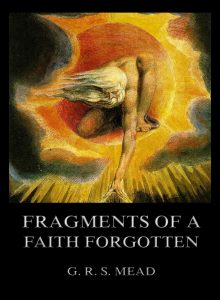Fragments Of A Faith Forgotten – G. R. S. Mead
The writing of the present work has been a congenial task to Mr. Mead, and he has brought to bear lovingly and zealously upon the portraiture of the figure of Christ and of early Christianity, all the knowledge which a deep study of Oriental religions from their emotional side could furnish.The outset that there is very little of what is commonly regarded as the Theosophic method apparent in the work, which is the product of a scholarly though withal very devotional spirit. Mr. Mead’s aim has been to enable the reader to obtain a glimpse of a world of which he has never heard at school, and of which no word is ever breathed from the pulpit; to take him away from the pictures which the rationalists and the apologists have presented, and to enable him to obtain an unimpeded view of that wonderful panorama of religious strife which the first two centuries of our era presented. He will here see a religious world of immense activity, a vast upheaval of thought and a strenuousness of religious endeavor to which the history of the Western world gives no parallel. Thousands of schools and communities on every hand, striving and contending, a vast freedom of thought, a mighty effort to live the religious life. Here he finds innumerable points of contact with other’ religions; he moves in an atmosphere of freedom of which he has previously had no experience in Christian tradition. Who are all these people—not fishermen and slaves and the poor and destitute, though those are striving too—but these men of learning and ascetic life, saints and sages as much as many others to whom the name has been given with far less reason ?

Fragments Of A Faith Forgotten
Format: Paperback.
Fragments Of A Faith Forgotten.
ISBN: 9783849675981.
Available at amazon.com and other venues.
G. R. S. Mead and the Theosophical Society (from wikipedia.com)
While still at Cambridge University Mead read Esoteric Buddhism (1883) by Alfred Percy Sinnett. This comprehensive theosophical account of the Eastern religion prompted Mead to contact two theosophists in London named Bertam Keightly and Mohini Chatterji, which eventually led him to join Helena Petrovna Blavatsky’s Theosophical Society in 1884.
In 1889 he abandoned his teaching profession to become Blavatsky’s private secretary, and also became a joint-secretary of the Esoteric Section (E.S.) of the Theosophical Society, reserved for those deemed more advanced.
Mead received Blavatsky’s Six Esoteric Instructions and other teachings at 22 meetings headed by Blavatsky which were only attended by the Inner Group of the Theosophical Society. It was because of the intimacy Mead felt with the Inner Group that he married Laura Cooper in 1899.
Contributing intellectually to the Theosophical Society, at first most interested in Eastern religions, he quickly became more and more attracted to Western esotericism in religion and philosophy, particularly Neoplatonism, Gnosticism, and Hermeticism, although his scholarship and publications continued to engage with Eastern religion. Making many contributions to the Theosophical Society’s Lucifer as joint editor, he eventually became the sole editor of The Theosophical Review in 1907 (as Lucifer was renamed in 1897).
As of February 1909 Mead and some 700 members of the Theosophical Society’s British Section resigned in protest at Annie Besant’s reinstatement of Charles Webster Leadbeater to membership in the society. Leadbeater had been a prominent member of the Theosophical Society until he was accused in 1906 of teaching masturbation to the sons of some American Theosophists under the guise of occult training. While this prompted Mead’s resignation, his frustration at the dogmatism of the Theosophical Society may also have been a major contributor to his break after 25 years.
(The text of the last section was taken from a Wikipedia entry and is available under the the Creative Commons Attribution-ShareAlike License.)
Publisher’s Note: This book is printed and distributed by Createspace a DBA of On-Demand Publishing LLC and is typically not available anywhere else than in stores owned and operated by Amazon or Createspace.
